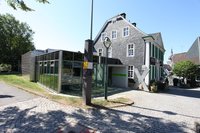Johann Wilhelm Hittorf (*27.03.1824 Bonn; +28.11.1914 Münster), Professor für Physik an der Universität Münster und Schöpfer der Hittorf'schen Vakuumröhren.
Einzelportrait (Bruststück) im Viertelprofil.
en

Johann Wilhelm Hittorf (*27.03.1824 Bonn; +28.11.1914 Münster), Professor für Physik an der Universität Münster und Schöpfer der Hittorf'schen Vakuumröhren.
Einzelportrait (Bruststück) im Viertelprofil.
Foto auf vorgedrucktem Karton, Unterschrift
Höhe: 10,6 cm, Breite: 5,9 cm
Remscheid-Lennep, der Geburtsort des Entdeckers der Röntgenstrahlen. Hier führen wir unsere Besucher durch eine spannende Erfahrungs- und...
Contact the institution[Last update: ]
